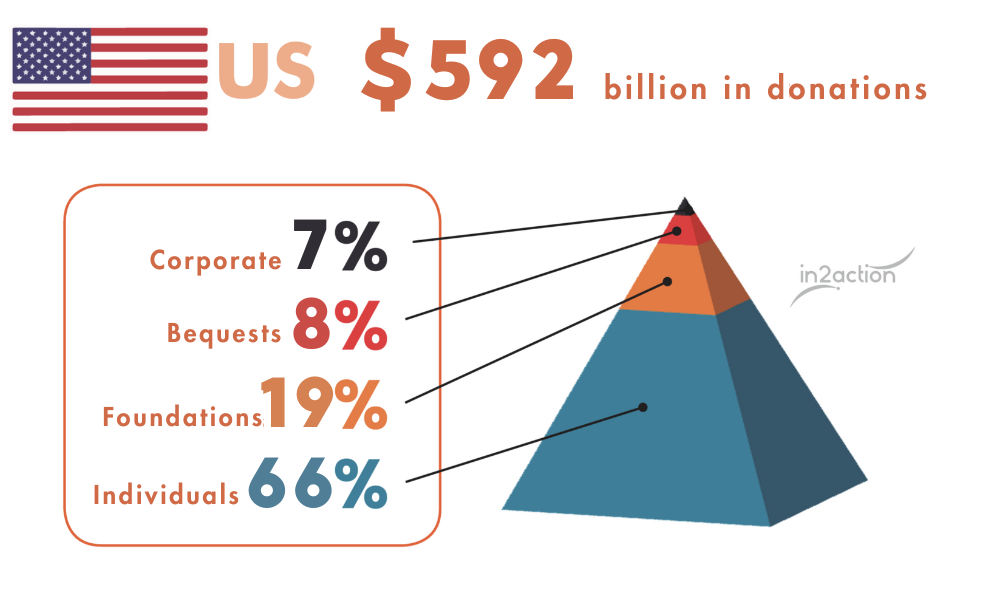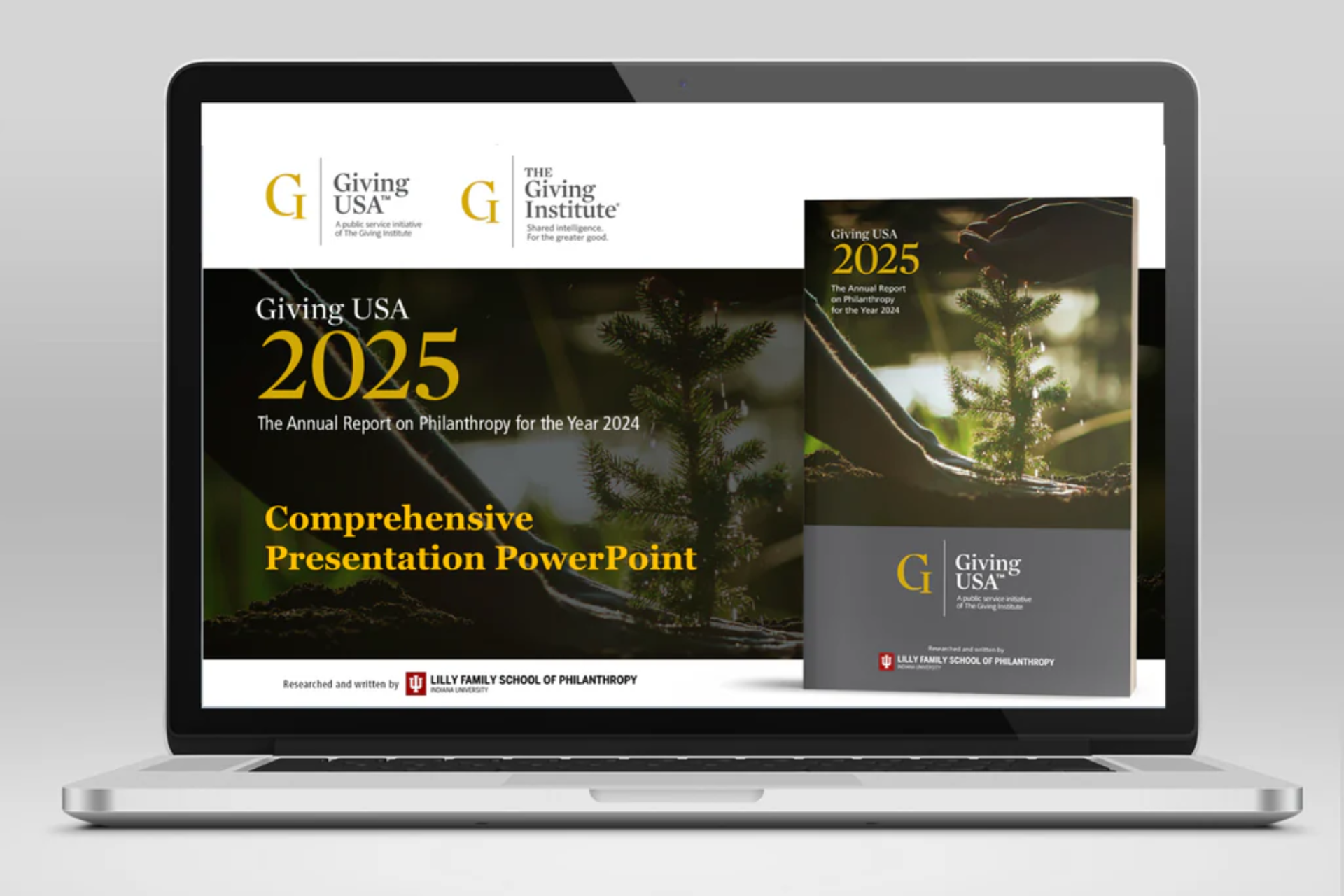By: Norma Galafassi
For another year, in2action is delighted to share key data on global GIVING. Today, specifically, web bring you the results of Giving USA 2025: The Annual Report on Philanthropy, presented by the research team at Indiana University’s Lilly School of Philanthropy and the fundraising professionals at the Giving USA Foundation.
Last year, there was some optimism that economic security would boost Americans’ generosity and lead to a resurgence in charitable giving. The terms “resilient” and “optimistic” predominated, amidst the economic improvements in the United States, as opposed to the uncertainty that slowed donations in 2023.
Donations to U.S. charities in 2024 reached an estimated $592 billion, a 6.3% growth in current dollars and a new record. For the first time in three years, donations also grew in inflation-adjusted dollars (3.3% in 2024), increasing non-profit sector’s ability to better fulfill their missions.
Donation growth has aligned with long-term trends in the sector, with a 40-year average growth of 5.5% in current dollars (2.7% adjusted for inflation).
Key facts:
- Total donations in 2024 in current dollars were US$592.5 billion in 2024, up from US$557.16 billion in 2023, representing an increase of 6.3% in current dollars and 3.3% adjusted for inflation.

All four sources of giving grew in current dollars, but only individuals and corporations experienced real (inflation-adjusted) growth. Bequests decreased slightly, and foundation donations remained stable when adjusted for inflation.
- Individuals donated US$392.45 billion, up 8.2% in current dollars and 5.1% when adjusted for inflation. Individuals were the largest source of donations, accounting for 66% of total contributions.
- Bequest donations decreased to US$45.84 billion, a 1.6% decrease in current dollars and a 4.4% decrease when adjusted for inflation. Bequests continue to represent 8% of total donations.
- Combining individual and bequest contributions, individuals still represent a total of 74% of all donations.
- Foundation giving reached $109.81 billion, an increase of 2.4% in current dollars but flat when adjusted for inflation (-0.5%), representing 19% of total giving, a long-term upward trend.
- Corporate giving reached the highest record on record at $44.4 billion, an increase of 9.1% in current dollars and 6.0% adjusted for inflation, driven by solid GDP growth and pre-tax corporate profits.
- A strong stock market contributed to the rise in the value of foundation assets, and their donations surpassed $100 billion for the third consecutive year.
- Foundations and corporations are steadily increasing their share of total giving, driven in part by the rise of Donor Advised Funds (DAFs).
And something more: if we look at donations by sector, seven of the nine subsectors experienced real growth in donations. Four subsectors reached record highs even after adjusting for inflation:
- Education: $88.32 billion (+13.2% current, +9.9% real)
- Healthcare: $60.51 billion (+5.0% current, +2.0% real)
- Arts, Culture, and Humanities: $25.13 billion (+9.5% current, +6.4% real)
- Environment/Animals: $21.57 billion (+7.7% current, +4.6% real).
- Donations to religion increased 1.9% in current dollars but decreased 1.0% when adjusted for inflation, continuing a decades-long trend of decline as a percentage of total donations.
- Public charities experienced an increase of 19.5% in current dollars and 16.1% when adjusted for inflation, reaching $66.84 billion, driven in part by growth in funds advised by donors (FAD).
Key Findings and Trends
- Mega-donations remain stable at around 3% of individual donations, despite a slight decline in the total ($11.9 billion in 2023 versus $11.7 billion in 2024). The consistency in the volume of mega-donations suggests that ultra-high-net-worth donors remain engaged and active in philanthropy. But there is still room for improvement!
- It is CRUCIAL to have solid strategies in place to reach high-net-worth individuals and multiply these donations.
- For the second consecutive year, Human Services organizations received the second largest share of U.S. philanthropy, surpassing Education in 2023 and maintaining that lead in 2024. This indicates that donors continue to prioritize basic needs and causes that support the community, especially in the wake of the pandemic’s disruptions and continued economic uncertainty.
- Although religious giving represented the largest share of philanthropy in the U.S., accounting for approximately 53% of donations in 1987, in 2024, religion received $146.54, falling below 25% of the total.
- The decline in donor numbers continues: While total charitable giving reached an all-time high in 2024, donor participation decreased by 4.5% between 2023 and 2024. This decline is not new, but it is accelerating, indicating an ongoing shift in which fewer donors are giving more money. Donor loss and low retention rates erode the income portfolio and future prospects.
- 2024 saw continued growth in donor-advised funds, which maintained $251 billion in assets despite market volatility. Wealthy donors are increasingly using donor-advised funds not only for current gifts, but also as part of their estate planning strategy. They name donor-advised fund sponsors as beneficiaries and create estate plans for their accounts rather than making direct charitable bequests. And when wealthy individuals plan their estates, they often eschew traditional wills altogether in favor of trusts and other sophisticated vehicles.
Perspective in a Time of Uncertainty
In 2025, as the US nonprofit sector faces significant disruption and uncertainty due to changes in federal policies regarding grantmaking and funding across different sectors, organizations across all sectors are forced to analyze and replan even as policies continue to change.
Once again, at in2action, we believe that understanding trends and data is always critical, particularly in the current environment. Donors will continue to donate to causes and missions they believe in and trust. Organizations that know where to focus, adapt, and how to most effectively reach their donors may achieve better outcomes. Therefore, it is always ESSENTIAL, in any country or context, to understand the current state of philanthropy and develop plans within organizations to inspire and motivate donors every day.

